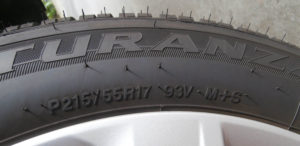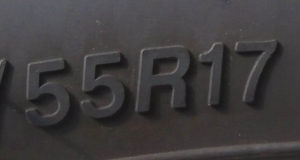
This is post number two in our series on understanding tire code. The universal tire code is found on every vehicle tire manufactured, and provides information about the type of tire it is, what type of vehicle it is designed for, and the type of driving it is intended to do.
In our last post, we talked about tire and section width. Today, we will look a little further into the code, and take a look at aspect ratio, tire construction, and wheel diameter.
Aspect Ratio

The aspect ratio of the tire is listed as a percentage and gives the height of the tire from the bead to the top of the tread. Here the number is 55, which means the tire height is 55% of the section width of 215 millimeters. The height of this tire would be 118.25 millimeters. A lower number indicates a lower tire profile.
Tire Construction
The construction of the tire is identified by the letter following the aspect ratio. The most common designation is R, which stands for radial construction. Other, less common construction types for modern passenger cars may include D for bias ply construction and B for belted tires.
Wheel Diameter
The number following the construction code indicates the size of the wheel that the tire will fit in inches. The example tire would be designed to fit a 17-inch wheel. Tire sizes on most vehicles begin at 13-inches and go up to 18-inches. Custom package wheels can be 22-inches or even larger.
An important sizing calculation in tire fitting, aspect ratio should be considered with wheel diameter for the best tire and wheel combinations. Lower aspect ratio typically indicates a high performance tire, with better lateral stability. Most of the new tires will be marked R for radial construction, however if you are replacing old tires, you may see the D or B designations.
When considering aspect ratio, tire construction, and wheel diameter, you should always select your vehicle manufacturer’s recommended specifications to assure safe and optimal tire performance. Just as choosing a dependable, quality tire is important, it also necessary to choose one that is developed for the best performance given the weight and design of your vehicle.
Next time, we will look at the remaining portion of the tire code, which includes Load Index, Speed Rating, and Use Designation.
